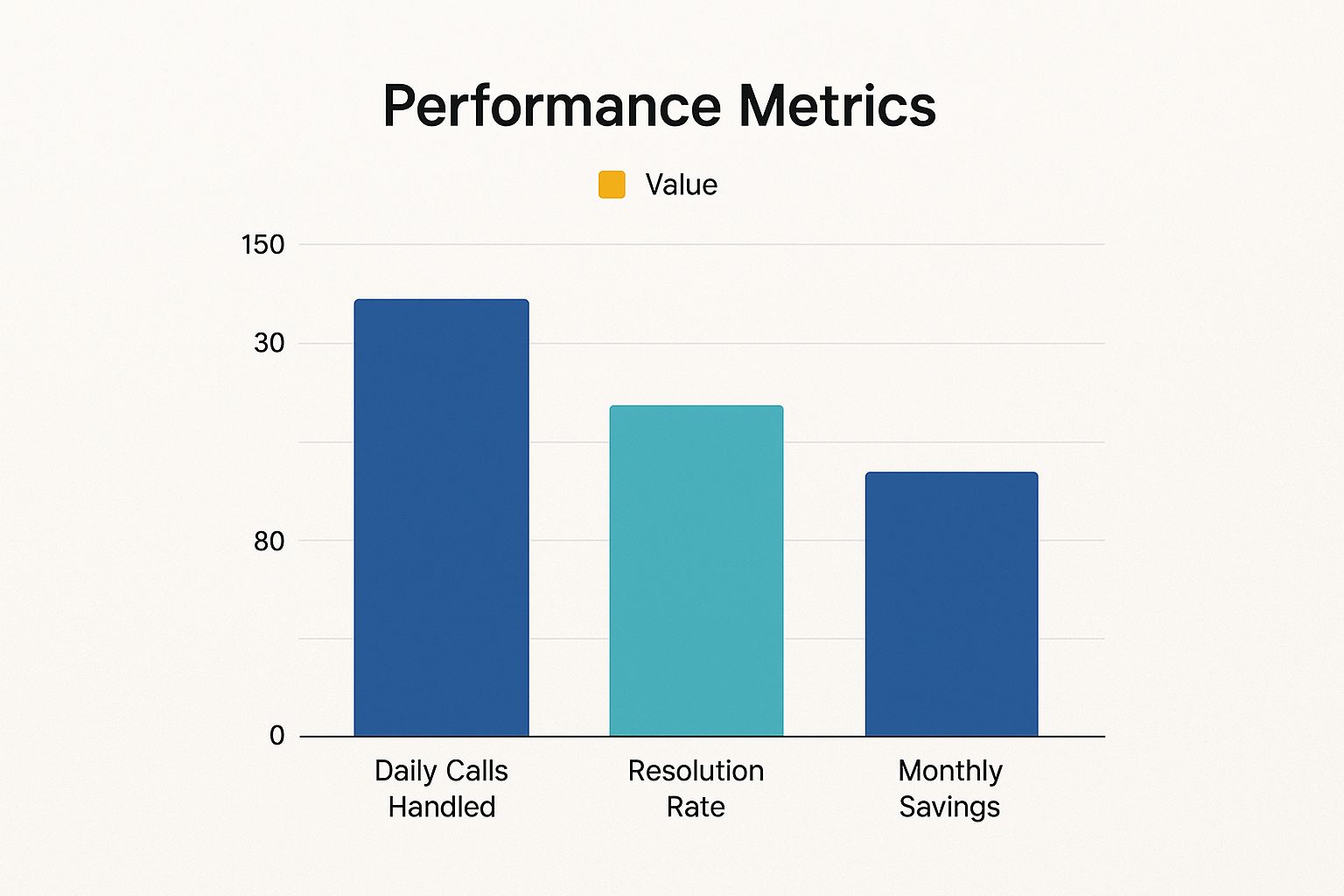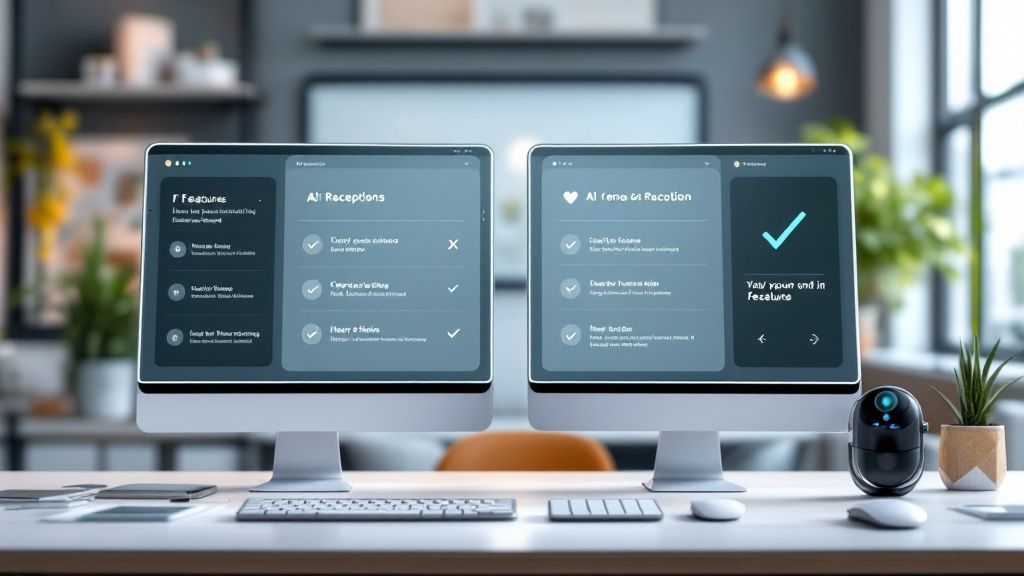So, what exactly is an AI virtual receptionist? Think of it less as a piece of software and more as a super-efficient digital team member designed to automatically handle all your incoming business calls. It uses artificial intelligence to answer calls instantly, figure out what the caller wants, and then gets to work scheduling appointments or directing the call to the right person. And it does this 24/7.
How An AI Virtual Receptionist Really Works

To get your head around how an AI virtual receptionist operates, don't picture a simple recording. Instead, imagine it's the brain of your phone system, processing information and making smart decisions in real-time, all without needing a human to step in. It’s a combination of a few clever technologies working together to create a smooth, professional experience for every single caller.
The real magic is its ability to understand normal human speech, thanks to a technology called Natural Language Processing (NLP). This is what allows it to ditch those rigid, "press-one-for-sales" menus and actually have a conversation.
When a customer calls and says, “I need to book a service for my car tomorrow afternoon,” the AI doesn't just hear words. It understands the intent—booking an appointment—and pulls out the key details like the service type and timing. Then, it takes action.
The Core Mechanics of Operation
An AI receptionist is built to manage every call with a logical flow that’s all about speed and accuracy. The goal is to make sure no caller is left waiting on hold or gets tangled up in a confusing phone tree.
Here’s a quick rundown of what it’s doing behind the scenes:
- Instant Call Answering: The system is always on, ready to pick up every call on the first ring. This completely eliminates missed calls and annoying wait times, ensuring you never lose a potential lead, even if they call in the middle of the night.
- Intelligent Call Routing: Based on what the caller says, the AI figures out the best place to send the call. It can flick a sales inquiry straight to your sales team, a support question over to your tech crew, or a billing issue to the right person in accounts.
- Automated Task Management: For all the routine stuff—like scheduling, cancelling, or answering common questions—the AI can handle the entire process by itself. It connects directly with your calendars and other business software to book appointments or provide info on the spot.
A huge part of what makes an AI virtual receptionist so effective is its use of advanced AI Conversational IVR technology. This allows the system to have dynamic, two-way chats instead of just playing old-school, pre-recorded messages.
For any business looking to modernise how they communicate, this technology is much more than a simple convenience—it’s a proper strategic tool. It takes your front desk from being a potential bottleneck and turns it into a seriously efficient, automated hub. Getting to grips with the basics of an automated phone answering system is the first step towards unlocking what it can really do for your business.
Key Features That Drive Real Business Growth
Knowing what an AI virtual receptionist does is one thing, but seeing how it actually beefs up your bottom line is where things get interesting. This isn't just a fancy call-answering gadget; it's a strategic tool built to deliver real, measurable wins in efficiency, customer happiness, and your overall business performance. Think of it as putting your front desk on autopilot so you can unlock some serious benefits across your entire operation.
One of the first things you'll notice is the power of uninterrupted 24/7 service. Your traditional receptionist has to go home eventually, but an AI system is always on the clock. This means you never miss a lead or leave a customer hanging, whether they call on a public holiday, late at night, or right in the middle of a crucial team meeting. For any business serious about growth, having that constant availability is a game-changer. It's why so many are looking into how an AI chatbot customer service setup can keep the doors open, digitally speaking.
That round-the-clock presence quickly translates into happier customers and more chances to bring in revenue.
Cost Savings and Operational Efficiency
Automating your front-desk tasks also leads to some pretty hefty cost savings. When you hire a full-time receptionist, you're not just paying a salary—there are benefits, training costs, and general overheads to think about. An AI virtual receptionist can handle a much higher volume of calls for just a fraction of the price, giving you a fantastic return on your investment.
This infographic gives a quick snapshot of what you can expect performance-wise.

As you can see, the numbers speak for themselves. An AI system manages a high volume of calls with ease and puts significant savings back into your pocket each month.
But the efficiency boost doesn't stop there; it ripples through to your human team as well. Let's compare the old way with the new.
Traditional Receptionist vs AI Virtual Receptionist
Here's a straightforward look at how the two stack up against each other.
| Feature | Traditional Receptionist | AI Virtual Receptionist |
|---|---|---|
| Availability | Limited to business hours (e.g., 9-5) | 24/7, including holidays and weekends |
| Cost | Full-time salary plus benefits and overheads | Low monthly subscription fee |
| Call Capacity | Can handle one call at a time | Can handle hundreds of calls simultaneously |
| Consistency | Performance can vary based on mood or workload | Consistently professional and accurate every time |
| Tasks | Answers calls, takes messages, basic scheduling | Advanced call routing, appointment booking, lead qualification |
| Scalability | Hiring more staff is slow and expensive | Scales instantly to handle call volume spikes |
The comparison makes it clear that while a human touch is invaluable for certain roles, an AI receptionist excels at handling the high-volume, repetitive tasks that often bog a business down.
This allows your team to focus on what truly matters. Australian businesses have found that AI receptionists can save front desk staff more than 2 hours per day. That’s time they can pour back into high-value work that needs a human touch, like building client relationships or strategic planning. The same data shows these systems capture around 97% of all calls—a huge leap from traditional setups where crucial enquiries often slip through the cracks.
By automating routine interactions, an AI virtual receptionist acts as a force multiplier for your team, allowing everyone to focus on what they do best without being constantly interrupted by a ringing phone.
Unlocking Your Team's Full Potential
When you free your staff from the constant ping of incoming calls, you're doing more than just saving them time. You’re empowering them to zero in on the core functions that actually move the needle for your business. Instead of just taking messages, they can be proactive with high-value clients, sort out complex problems, and contribute to bigger, more ambitious projects.
This shift turns your administrative staff from reactive call-catchers into proactive, valuable contributors. A solid AI answering service handles all the routine stuff flawlessly, giving your team the breathing room they need to really shine. This focus doesn't just boost productivity; it also makes their work more meaningful, which is a massive win for job satisfaction and keeping great people around.
Balancing Automation With The Human Touch

While the raw efficiency of an AI virtual receptionist is a massive win, the conversation isn't about replacing your team. Not at all. The smartest businesses are figuring out how to blend the two, creating a hybrid model that pairs the instant response of AI with the irreplaceable value of a real human.
It’s all about giving customers the best of both worlds. They get lightning-fast answers for simple things and a genuinely empathetic ear for the complex stuff.
The trick is knowing where each one shines. AI is brilliant at handling the high-volume, repetitive tasks that can bog down a front desk. Think of it as the ultimate first line of defence, flawlessly managing routine queries so your team can focus on what they do best.
This isn't just a nice theory, either. Data from Australian businesses backs it up. While AI is great for speed, customers still crave that human connection. Satisfaction rates for human interactions are sitting pretty at 88%, a long way ahead of the 60% for purely AI-driven chats. With around 40% of Australians still not quite comfortable with fully automated service, it’s a clear signal that having a human safety net is vital for building trust.
If you're keen to dive deeper into these trends, you can discover insights on how AI is changing jobs in Australia.
Where AI Shines and Humans Excel
To really make this hybrid approach work, you need to play to your team's strengths—both digital and human. It’s about letting the tech handle the grunt work so your skilled people can step in for the moments that truly matter. This division of labour boosts your efficiency without ever sacrificing the quality of your customer relationships.
AI is the perfect choice for:
- 24/7 Availability: Answering calls instantly, day or night. You'll never miss a lead again.
- Routine Scheduling: Booking, confirming, or cancelling appointments without anyone lifting a finger.
- Answering FAQs: Firing off quick, consistent answers to common questions about your hours, location, or services.
- Initial Lead Qualification: Gathering the basic details from a new caller before passing them smoothly to your sales team.
A human agent is essential for:
- Complex Problem-Solving: Tackling those unique customer issues that a script could never solve.
- Handling Emotional Conversations: Offering genuine empathy to a frustrated or distressed client.
- Building Client Relationships: Having real conversations that build loyalty and make people feel valued.
- High-Value Sales Negotiations: Navigating those nuanced discussions that require intuition and a personal touch.
The goal of a hybrid model is seamless escalation. An AI virtual receptionist can handle the initial contact, gather details, and then intelligently transfer the call—along with all the context—to a human agent, who can pick up the conversation without missing a beat.
This smart handoff is what modern customer service is all about. It proves that bringing in an AI virtual receptionist isn't about cutting staff—it’s about empowering them. By automating the mundane, you free up your team to pour their energy into the high-impact interactions that define your brand and keep customers coming back.
Real-World Australian Business Success Stories
The real proof of an ai virtual receptionist isn't in a flashy brochure or a list of technical specs—it's in the real-world results it gets for actual businesses. All across Australia, businesses are using this tech to fix nagging problems, from drowning in phone calls to losing leads that ring after everyone’s gone home. These stories show just how much of a game-changer a little bit of smart automation can be.
Think about it. A potential customer calls, no one picks up, and that lead vanishes. It's a simple problem, but a costly one. By getting an AI system on board, businesses are making sure every single call gets answered, day or night. What was once a missed opportunity is now a new client, a booked job, or a solid lead.
This is more than just answering the phone. It’s about completely changing that first point of contact with your customers for the better.
Boosting Efficiency in Australian Healthcare Clinics
Picture a busy physiotherapy clinic in Melbourne. The front desk was a constant battlefield. The reception staff were juggling a non-stop flood of calls while trying to help patients standing right in front of them. The result? Frustratingly long hold times, rushed conversations, and a high rate of no-shows because reminder calls were getting missed in the chaos.
They brought in an ai virtual receptionist to take over all the incoming calls for bookings, cancellations, and general questions.
The change was instant and pretty dramatic:
- No-Shows Plummeted: The AI handled all the appointment confirmations and reminder calls automatically. Within the first three months, they saw a 25% drop in no-shows.
- Staff Could Finally Breathe: With the phones handled, the reception team could give their full attention to the patients in the clinic, sort out tricky billing questions, and keep the whole place running smoothly.
- Always Open for Business: Patients loved that they could book or change appointments whenever it suited them, even late at night. This kept them happy and helped fill up empty spots in the calendar.
This clinic's story really drives home a key point: an AI receptionist doesn't replace your team; it supercharges them. It handles all the repetitive, high-volume stuff, freeing up your people to focus on providing top-notch patient care.
Transforming Lead Capture for Real Estate Agencies
For a real estate agency in Sydney, the problem was a bit different but just as urgent. Enquiries about properties were coming in at all hours, long after the office had closed for the day. A potential buyer would spot a listing online in the evening, give them a bell, and get nothing. Those hot leads were often lost to a competitor who was quicker to respond.
The agency set up an AI receptionist specifically to handle property enquiries. When a call came in, the AI could answer basic questions about a listing, book a viewing straight into the agent's calendar, and grab the caller's details for a follow-up.
This one move completely overhauled their lead management. The agency saw a massive 40% jump in qualified leads coming in after hours and on weekends. Agents could walk into the office in the morning with a list of pre-vetted, scheduled viewings waiting for them. It let them focus on what they do best—closing deals, not chasing down missed calls. It just goes to show, being the first to answer often means you get the business.
Your AI Implementation Checklist

Bringing an AI virtual receptionist into your business isn’t as simple as flicking a switch. To get it working for you from day one, you need a clear strategy. A bit of thoughtful planning now helps you sidestep common hurdles and integrate this powerful tool into your operations without a hitch. The goal is to set it up for success so it feels like a natural part of how you do business.
Think of this checklist as your roadmap. Following these steps will help you figure out exactly what you need, pick the right partner, and customise the system to act as a true extension of your brand.
Define Your Goals and Scope
Before you even start looking at providers, you need to be crystal clear on what problem you’re actually trying to solve. Are you losing leads after hours? Is your front desk staff swamped with routine appointment bookings? Pinpointing your main pain points is the single most important first step.
From there, you can set clear, measurable goals for what you want the AI to achieve. This could be anything from cutting down missed calls by a certain percentage to boosting your lead capture rate on weekends.
- Identify Core Tasks: Jot down the top 3-5 repetitive tasks you want the AI to handle. Think scheduling, answering frequently asked questions, or qualifying new leads.
- Establish Key Metrics: Decide how you’ll measure success. Will it be call resolution rates, the number of appointments booked, or a reduction in operational costs? Checking out our guide on understanding virtual receptionist costs can help you budget effectively.
Select and Customise Your Solution
Once you know what you need, it's time to choose a provider and get the system tailored to your business. Let’s be real: not all AI receptionists are created equal. You’ll want to look for a solution that plays nicely with the tools you already use, like your CRM and calendar software.
The best AI virtual receptionist solutions offer deep customisation. You should be able to create custom call flows, develop scripts that match your brand’s voice, and decide exactly how and when calls get escalated to a human team member.
Getting this integration right can be tricky. A recent survey from the Governance Institute of Australia found that a massive 88% of organisations struggled to fit generative AI into their existing IT systems. The report also pointed to a skills gap, with only 10% of professionals holding advanced AI qualifications, which makes finding a user-friendly platform even more critical. You can read the full report on AI deployment challenges for a deeper dive.
Finally, get your team ready for the change. It’s crucial to explain that the AI is there to support them, not replace them. Give them clear training on how the system works and how they can work with it to provide an even better customer experience.
Common Questions About AI Receptionists
Bringing an AI virtual receptionist into your business is a big move, and it's totally normal to have a few questions. Getting straight answers is the best way to feel good about your decision, so let’s tackle some of the most common queries that pop up for business owners.
Is an AI Receptionist Worth the Cost?
Let's get right to it: the money question. Is this tech actually a smart investment? When you stack up a monthly subscription against the salary of a full-time receptionist—which can easily top $40,000 a year before you even think about benefits—the savings are pretty clear from day one.
But the real value isn't just about cutting payroll. An AI receptionist is on the clock 24/7. That means you stop losing those valuable leads who call after hours, on weekends, or during a public holiday. Every single call that gets answered is another shot at landing a new client or booking a job, which makes the return on investment incredibly strong.
Think about what just one missed lead costs you. For a lot of businesses, losing one or two high-value clients a month because no one was there to pick up the phone would easily cover the cost of an AI solution. It shifts your phone system from being a business expense to a reliable way of generating revenue.
It also gives your team a massive efficiency boost. By taking over routine stuff like scheduling appointments and answering the same old questions, an AI system frees up your crew to focus on the complex, high-value work that actually grows your business.
How Secure Is My Business Data?
Handing over customer conversations to any new system naturally brings up security. It's a big deal. Protecting sensitive information is non-negotiable, and any reputable AI virtual receptionist provider will treat it as their absolute top priority.
The best platforms are built with serious security measures baked in to keep your data safe. This usually includes:
- Data Encryption: All your information is scrambled, both when it's being sent and when it's stored. This makes it completely unreadable to anyone who doesn’t have the keys.
- Compliance with Privacy Laws: Good providers stick to strict data protection rules, like the Privacy Act here in Australia, making sure your customer information is handled legally and ethically.
- Secure Infrastructure: Their systems are housed in secure data centres with all the physical and digital locks needed to prevent unauthorised access.
When you're looking at different providers, be sure to ask them how they handle security. A partner you can trust will be upfront and clear about the steps they take to protect your business and your customers' data.
This focus on security means you can get all the benefits of an automated system without having to worry about the privacy and trust you’ve worked so hard to build with your clients.
Can It Understand Different Accents and Requests?
A common worry, especially in a place as diverse as Australia, is whether an AI can actually keep up with all the different accents and ways people talk. The good news is that modern AI systems are trained on massive, incredibly varied datasets, making them surprisingly good at understanding a wide range of speech patterns.
They use advanced natural language processing, which means they're listening for the intent behind the words, not just specific keywords. A caller doesn't need to speak like a robot to be understood; the AI is designed to handle a natural, human conversation.
Of course, no technology is perfect. For those tricky moments when a request is too complex, the caller is upset, or it just needs a human touch, the system knows its limits. It's programmed to intelligently recognise when it’s out of its depth and will seamlessly transfer the call to a designated person on your team. It even provides them with the context of the chat so they can jump in and take over without a hitch.
Ready to stop missing calls and start saving hours every week? Discover how OnSilent can manage your communications effortlessly, ensuring you capture every opportunity. Learn more at OnSilent.

